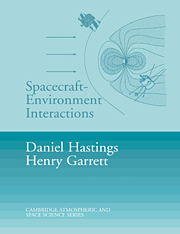Book contents
- Frontmatter
- Contents
- List of Illustrations
- List of Tables
- Preface
- Acknowledgment
- 1 Introduction
- 2 Fundamental Length, Time, and Velocity Scales
- 3 The Ambient Space Environment
- 4 Neutral Gas Interactions
- 5 Plasma Interactions
- 6 The Space Radiation Environment
- 7 Particulate Interactions
- 8 The State of the Art
- References
- Index
3 - The Ambient Space Environment
Published online by Cambridge University Press: 30 September 2009
- Frontmatter
- Contents
- List of Illustrations
- List of Tables
- Preface
- Acknowledgment
- 1 Introduction
- 2 Fundamental Length, Time, and Velocity Scales
- 3 The Ambient Space Environment
- 4 Neutral Gas Interactions
- 5 Plasma Interactions
- 6 The Space Radiation Environment
- 7 Particulate Interactions
- 8 The State of the Art
- References
- Index
Summary
In this chapter, the principal natural (unperturbed) environments responsible for spacecraft interactions are introduced. These are the solar environment, the neutral atmosphere, the geomagnetic field, the plasma environment, the geostationary environment, energetic particle radiation, electromagnetic and optical radiation, and particulates (debris and meteoroids). The ambient space environment defined by these components has been the subject of numerous books and review papers [e.g., Jursa (1985)] or the excellent short descriptions of the environment in MIL-STD-1809 (1991). Unlike most of these sources, which deal primarily with the details of the space environment, the intent here is to provide the reader with sufficient background to evaluate the potential impact of the environment – both natural and man-made – on a spacecraft.
The relationships between the orbit classes and the natural environment are summarized in Figure 3.1. Table 3.1 is used to indicate which environments must be considered for a given class of orbits.
Influence of the Sun
The dominant energy source for the space environment in the solar system is the Sun. The chief solar influence on the space environment is through its electromagnetic flux (see Section 3.4.2) and the charged particles that it emits. The solar particle flux is composed basically of two components: the very sporadic, high-energy (E > 1 MeV) plasma bursts associated with solar events (flares, coronal mass ejections, proton events, and so forth) and the variable, low-energy (E ≈ tens of eV) background plasma referred to as the solar wind.
- Type
- Chapter
- Information
- Spacecraft-Environment Interactions , pp. 44 - 99Publisher: Cambridge University PressPrint publication year: 1996
- 4
- Cited by



